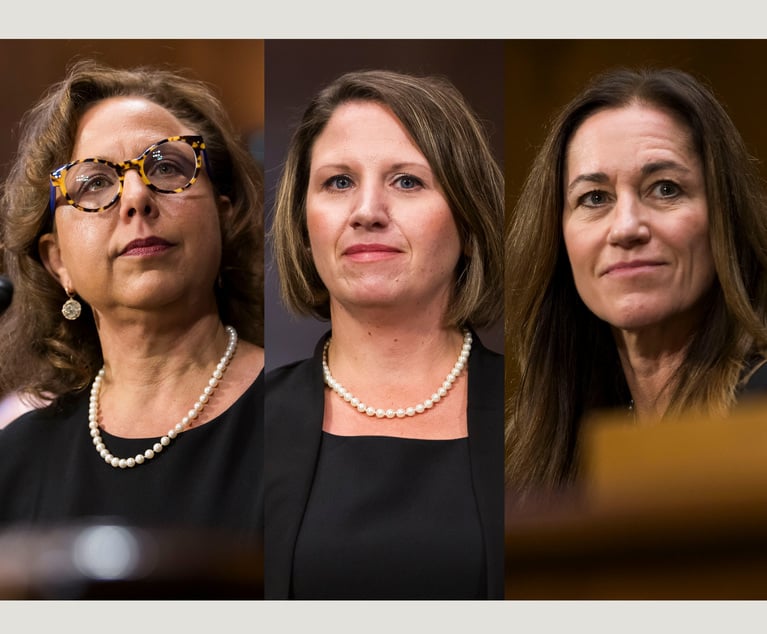3M Earplugs: Profits Over Protection for Those Who Serve?
Unbeknownst to the U.S. military, some equipment may undergo inadequate testing and contain flaws or defects that can result in life-altering injuries for our service members. This is the current situation in the 3M Earplug litigation.
June 10, 2019 at 11:32 AM
8 minute read
 Shayna Slater of Anapol Weiss.
Shayna Slater of Anapol Weiss.
“To care for him who shall have borne the battle, and for his widow, and his orphan.”
This was Abraham Lincoln's request of all American's during his second inaugural address and is prominently displayed upon entering the Department of Veterans Affairs. It is hard to disagree that our service men and women should be protected and cared for to the best of our abilities. Previously, when I read this quote, I envisioned health care, housing, child care and the such. While all of those are undoubtedly important, in the last few months my thoughts have also included ensuring that products or devices provided to our troops are top of the line in both performance and safety.
Prior to any deployment or training exercise, service members are provided with standard issue equipment. That equipment, one would think, includes thoroughly tested items that have met rigorous safety standards. However, as is often the case, what should happen and what actually happens may be two different things. In fact, unbeknownst to the U.S. military, some equipment may undergo inadequate testing and contain flaws or defects that can result in life-altering injuries for our service members. This is the current situation in the 3M Earplug litigation.
3M Combat Arms Earplugs
3M manufactured and exclusively provided earplugs to the U.S. military from approximately 2003 to 2015. It is alleged that the 3M Combat Arms Earplugs, version 2 (CAEv2) were knowingly provided to the military with defects that rendered them inadequate to provide appropriate or anticipated noise protection. The earplugs were designed to provide two different options for hearing protection. If worn in the closed position (olive green side), the earplugs should have blocked as much sound as possible. If worn in the open position (yellow side), the earplugs should have reduced impulse noises but still allowed the service member to hear other noises such as commands.
However, it is alleged that the CAEv2 earplugs were too short to be properly inserted and would imperceptibly loosen during use which, unbeknownst to the service members, exposed them to dangerous combat noise. As the alleged defect was unknown both to the military and the service members, individuals continued to wear these earplugs causing permanent hearing loss and tinnitus.
The United States sued 3M and its predecessor, Aearo Technologies, Inc., under the qui tam provisions of the False Claims Act based on 3M's alleged failure to disclose the design defect to the U.S. military. In July 2018, 3M agreed to pay $9.1 million to resolve the allegations that they knowingly supplied the United States with defective combat earplugs without any admission or determination of liability. At that time, acting Assistant Attorney General Chad A. Readler stated, “The Department of Justice is committed to protecting the men and women serving in the U.S. military from defective products and fraudulent conduct. Government contractors who seek to profit at the expense of our military will face appropriate consequences.” While the United States certainly exhibited their unwillingness to sit idly by while defective products are provided to their service men and women, this settlement will not compensate the service members injured by this product. Instead, it is a repayment to the U.S. military. If a service member was injured by the CAEv2 earplugs and wishes to seek compensation for those injuries, they must file an individual lawsuit against 3M.
Hearing Loss or Tinnitus
At the outset, hearing loss and tinnitus may not seem like life-altering injuries. However, after speaking with numerous military men and women, who depended on these earplugs for hearing protection, you quickly realize that the damages are significant. Tinnitus, often referred to as ringing in the ears, can be a constant buzzing, ringing, hissing or high-pitched whistle that can vary in severity. It can affect numerous aspects of a service member's life including their ability to sleep and participate in social interactions. It can also result in severe stress and anxiety, trigger headaches and migraines and affect the ability to concentrate or relax. Unfortunately, there are very few effective treatments for tinnitus. Sadly, many of our veterans will endure this for the rest of their lives without relief.
Hearing loss can also be a devastating injury. Noise-induced hearing loss often affects a younger population and can be caused by a one-time exposure to a loud impulse noise such as an explosion or repetitive noise exposure over time. Hearing loss can affect a service members physical and emotional well-being and lead to a host of issues including headaches, increased stress, difficulty maintaining relationships, depression, withdrawal from social situations and difficulty communicating. This hearing loss is permanent and will only worsen with age.
Potential Issues in the Litigation
As this litigation is still in its infancy, the battles ahead are likely numerous. However, two of the likely hurdles our soldiers face include:
- Government Contractor Immunity
This defense would allow a private contractor such as 3M to shield itself behind the government's sovereign immunity. In Boyle v. United Technologies, the court set forth a three-pronged test that a private contractor would need to pass to prevail under the government contractor defense. The court found that “state law which imposes liability for design defects in military equipment is displaced where The United States approved reasonably precise specifications; the equipment conformed to those specifications; and the supplier warned the United States about dangers in the use of the equipment known to the supplier but not to the United States.” A key factor in this case will be whether the U.S. military approved specifications for the earplug's shortened stem with knowledge of the risks associated with that shorter length.
- Combat Activities Exception
This exception insulates the U.S. government from tort liability for any claim arising out of the combatant activities of the military or naval forces, or the Coast Guard, during a time of war, see 28 U.S.C. Section 2680(j). The circuits are split on the application of the combat activities exception to government contractors. In Bentzlin v. Hughes Aircraft, the court extended the application of the combatant activities exception to government contractors based on product liability. The Bentzlin court stated: “The balancing of interests of fitness of design, quality of manufacture, immediacy of delivery, and thoroughness of training is essential to the conduct of war. Decisions must be made and compromises accepted in the national interest by the government and its contractors without fear of the consequences of civil liability. Indeed, federal interests would be frustrated if discovery was required to determine whether a malfunction was caused by the United States' wartime policy or a manufacturer's shoddy workmanship.”
In sharp contrast, the court in McMahon v. General Dynamics, found that the combat activities exception does not bar a service members manufacturing defect claim against a private military contractor. The McMahon court noted, “The rationales for immunizing the government or military personnel have no straightforward application to a government-contractor defendant that manufacturers a defective product which injures a U.S. soldier … It is a fact of life that the enemy seeks to injure us; that is no reason to forego the best means we have of ensuring that we do not injure ourselves.”
It is yet to be seen whether 3M will try to shield itself under either of the above doctrines. However, the United States asserted in the qui tam complaint that the defect was never disclosed to them. If that is true, 3M may have a difficult time escaping liability.
Current Developments
Recently the U.S. Judicial Panel on Multidistrict Litigation coordinated these lawsuits against 3M before U.S. District Judge M. Casey Rodgers of the Northern District of Florida. This MDL will likely house thousands of complaints against 3M.
Although there are known risks to war that our military bravely accept, when they are provided with a product intended to protect them it should perform as promised. As Abraham Lincoln expounded, we must protect those who put their lives in danger to protect us.
Shayna T. Slater, a partner at Anapol Weiss, concentrates her practice on mass tort, products liability and other civil litigation. Her practice involves both pharmaceutical and medical device mass tort litigation. Contact her at [email protected].
This content has been archived. It is available through our partners, LexisNexis® and Bloomberg Law.
To view this content, please continue to their sites.
Not a Lexis Subscriber?
Subscribe Now
Not a Bloomberg Law Subscriber?
Subscribe Now
NOT FOR REPRINT
© 2025 ALM Global, LLC, All Rights Reserved. Request academic re-use from www.copyright.com. All other uses, submit a request to [email protected]. For more information visit Asset & Logo Licensing.
You Might Like
View All
Pa. Federal District Courts Reach Full Complement Following Latest Confirmation

The Defense Bar Is Feeling the Strain: Busy Med Mal Trial Schedules Might Be Phila.'s 'New Normal'
7 minute read
Federal Judge Allows Elderly Woman's Consumer Protection Suit to Proceed Against Citizens Bank
5 minute read
Judge Leaves Statute of Limitations Question in Injury Crash Suit for a Jury
4 minute readTrending Stories
Who Got The Work
J. Brugh Lower of Gibbons has entered an appearance for industrial equipment supplier Devco Corporation in a pending trademark infringement lawsuit. The suit, accusing the defendant of selling knock-off Graco products, was filed Dec. 18 in New Jersey District Court by Rivkin Radler on behalf of Graco Inc. and Graco Minnesota. The case, assigned to U.S. District Judge Zahid N. Quraishi, is 3:24-cv-11294, Graco Inc. et al v. Devco Corporation.
Who Got The Work
Rebecca Maller-Stein and Kent A. Yalowitz of Arnold & Porter Kaye Scholer have entered their appearances for Hanaco Venture Capital and its executives, Lior Prosor and David Frankel, in a pending securities lawsuit. The action, filed on Dec. 24 in New York Southern District Court by Zell, Aron & Co. on behalf of Goldeneye Advisors, accuses the defendants of negligently and fraudulently managing the plaintiff's $1 million investment. The case, assigned to U.S. District Judge Vernon S. Broderick, is 1:24-cv-09918, Goldeneye Advisors, LLC v. Hanaco Venture Capital, Ltd. et al.
Who Got The Work
Attorneys from A&O Shearman has stepped in as defense counsel for Toronto-Dominion Bank and other defendants in a pending securities class action. The suit, filed Dec. 11 in New York Southern District Court by Bleichmar Fonti & Auld, accuses the defendants of concealing the bank's 'pervasive' deficiencies in regards to its compliance with the Bank Secrecy Act and the quality of its anti-money laundering controls. The case, assigned to U.S. District Judge Arun Subramanian, is 1:24-cv-09445, Gonzalez v. The Toronto-Dominion Bank et al.
Who Got The Work
Crown Castle International, a Pennsylvania company providing shared communications infrastructure, has turned to Luke D. Wolf of Gordon Rees Scully Mansukhani to fend off a pending breach-of-contract lawsuit. The court action, filed Nov. 25 in Michigan Eastern District Court by Hooper Hathaway PC on behalf of The Town Residences LLC, accuses Crown Castle of failing to transfer approximately $30,000 in utility payments from T-Mobile in breach of a roof-top lease and assignment agreement. The case, assigned to U.S. District Judge Susan K. Declercq, is 2:24-cv-13131, The Town Residences LLC v. T-Mobile US, Inc. et al.
Who Got The Work
Wilfred P. Coronato and Daniel M. Schwartz of McCarter & English have stepped in as defense counsel to Electrolux Home Products Inc. in a pending product liability lawsuit. The court action, filed Nov. 26 in New York Eastern District Court by Poulos Lopiccolo PC and Nagel Rice LLP on behalf of David Stern, alleges that the defendant's refrigerators’ drawers and shelving repeatedly break and fall apart within months after purchase. The case, assigned to U.S. District Judge Joan M. Azrack, is 2:24-cv-08204, Stern v. Electrolux Home Products, Inc.
Featured Firms
Law Offices of Gary Martin Hays & Associates, P.C.
(470) 294-1674
Law Offices of Mark E. Salomone
(857) 444-6468
Smith & Hassler
(713) 739-1250





